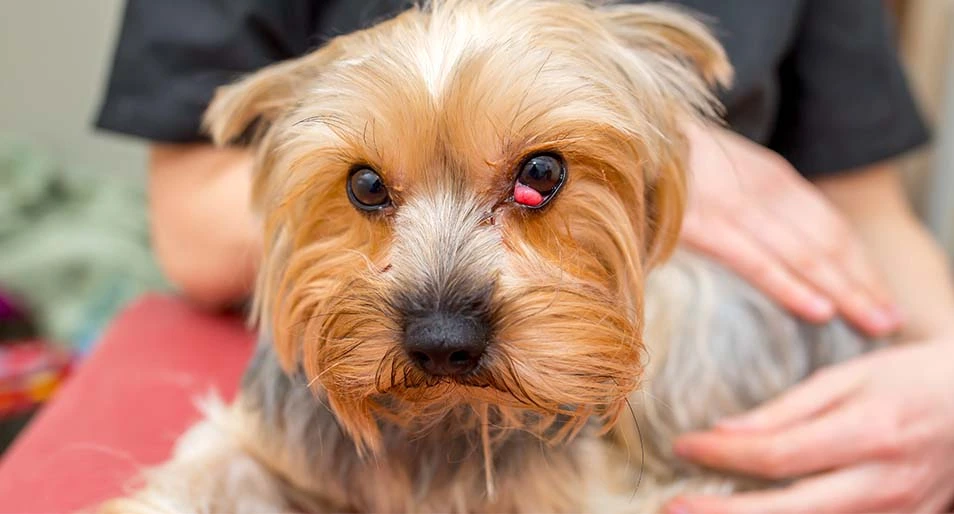PET HEALTH
Cherry Eye Surgery Cost: What To Expect
Cherry eye surgery in dogs usually costs between $300 and $1,900, though costs can vary based on the type of vet that performs the surgery and whether one or both eyes need to be repaired. Because cherry eye can cause issues like dry eye and eye infections, surgery is often the best treatment option for your pup.1
If your dog has a cherry eye, pet insurance may help cover some of the costs and can make it easier to give your pup the care they deserve. Below, we’ll break down what cherry eye is, what surgery costs to expect, and how insurance can help you manage these expenses.
Cherry Eye Can Be Scary. Vet Bills Don’t Have To Be.
What Is Cherry Eye in Dogs?
Cherry eye is a condition where the tear gland in a dog’s third eyelid prolapses, or slips out of its normal position. The prolapsed gland becomes swollen and creates a cherry-like bulge in the inner corner of the eye or lower eyelid.2,3
A dog’s third eyelid, also called the nictitating membrane, acts as an extra layer of protection for their eyes. It helps shield the eyes from dirt and scratches, but it also contains tear glands that keep their eyes moist and healthy.3
While cherry eye might not cause your dog any pain, it can lead to discomfort, dryness, and even eye infections if left untreated.2
What causes it?
The exact cause of cherry eye isn’t always clear, but it’s often linked to weak connective tissue, like the ligament that holds the tear gland in place.2
Certain dog breeds are more likely to develop cherry eye because of their genetic makeup, like:2
- Boston terriers
- Bulldogs
- Beagles
- Cocker spaniels
- Rottweilers
- Maltese
Other factors, like eye irritation or trauma, can sometimes trigger cherry eye, too.2
Thankfully, with the right treatment — like surgery — you can help your furry friend feel better. Surgery is often recommended to correct cherry eye because it restores the gland to its normal position and can help ensure your dog’s tear production works properly.
How Much Does Cherry Eye Surgery Cost?
On average, cherry eye surgery for dogs can cost between $300 and $1,900.1 When considering surgery costs, it can be helpful to know what may be included in the estimate. Common expenses are:
- Pre-op and post-op vet appointments evaluate your dog’s condition and monitor their recovery after cherry eye surgery.
- Examinations and diagnostics, like blood tests, are done to further assess your dog’s health and ensure a safe procedure.
- Anesthesia is used to keep your pup comfortable during surgery.
- Prescription medications are to prevent eye infections and manage any pain after the surgery.
Ask your vet for a detailed estimate to avoid any surprises and clarify whether certain treatments, like anesthesia and follow-up care, are included in the overall cost.
What Affects the Cost of Cherry Eye Surgery?
Several factors can influence the cost of your dog’s cherry eye surgery, including the following:4
- The severity of the cherry eye: More complicated cases of cherry eye may need extra care or specialized surgical techniques.
- Your dog’s size, age, and breed: Bigger dogs might need more anesthesia, and some breeds are more prone to cherry eye, which can affect the overall cost of surgery.
- Whether one or both eyes need surgery: Fixing cherry eye in both eyes will typically cost more than treating just one.
- Where the vet practice is located: Costs can differ depending on whether you visit a low-cost clinic, your regular vet, or a specialized surgical center.
- Additional treatments or complications: If your pup has other eye health issues that need to be addressed, like problems with their cornea, it might add to the overall bill.
Understanding these variables can make it easier to prepare and find the best care for your pup. Pet insurance can also be a big help in managing the costs associated with cherry eye surgery.
Does Pet Insurance Cover Cherry Eye Surgery?
MetLife Pet Insurance may be able to cover some of the costs of cherry eye surgery. For example, Luna, a mixed-breed pup from California, underwent cherry eye surgery. This cost about $690. Because Luna’s family had a dog insurance policy through MetLife Pet, they were reimbursed around $590.5
In some cases, MetLife Pet may also be able to help you cover the cost of vet visits before and after surgery, as well as diagnostic tests, medications, and other treatment costs.
Keep in mind that cherry eye surgery might not be covered if it’s considered a pre-existing condition — meaning it was diagnosed or your dog showed symptoms before your policy started. Check your plan’s coverage details so you know what to expect.
How To Help Your Dog Recover From Cherry Eye Surgery
Helping your dog recover from surgery is all about giving them the care and attention they need to heal comfortably. Your vet will likely recommend an Elizabethan collar (E-collar) to stop your pup from scratching or pawing their eyes. Your vet may also give anti-inflammatory eye drops or medication to help with swelling and prevent infections.6
Keep an eye on your pup during the recovery process. It often takes anywhere from 10 – 14 days for your dog to heal. If you notice any adverse signs, like extra redness or swelling around their eyes, don’t hesitate to check in with your vet. With proper care, most dogs are back to their normal selves in no time.6
Caring for Your Dog’s Eye Health
Surgery could be the best way to treat a cherry eye in dogs. Although costs can vary, pet insurance may help you cover the cost of surgery, vet exams before and after the procedure, medications, and other treatments.
Are you ready to take the next step in protecting your pet’s health? Get a personalized quote today.
Pet Insurance Can Help You Cover Your Pup’s Cherry Eye Surgery
Dr. Hunter Finn has been paid by MetLife to discuss the importance of choosing pet insurance. He is an integrative veterinary expert first, and social media star second. America’s favorite veterinarian owns Pet Method in McKinney, Texas, where he cares for pets while prioritizing their emotional well-being. When he’s not at his clinic, he’s starring in viral videos on TikTok (2 million followers) and Instagram (500K followers) — where he’s been known to snuggle puppies and conquer the latest dance trends.



